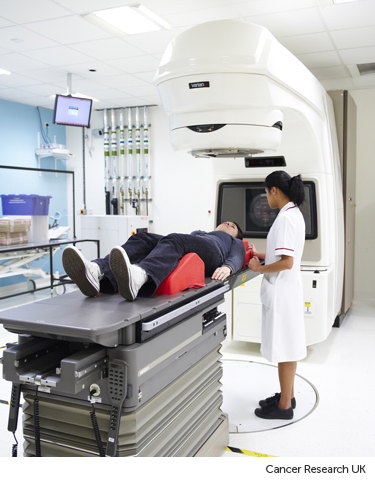Radiotherapy for blood vessel blockage (SVCO)
Cancer can block or press on the vein that carries blood back to the heart (superior vena cava). Blockage of this vein is called superior vena cava obstruction (SVCO). You might have radiotherapy to help shrink the cancer and relieve the blockage.
Who gets SVCO?
Lung cancer near the superior vena cava is usually the cause of SVCO.
It can also be caused by:
- non-Hodgkin lymphoma
- other cancers that started or spread near to the vein
- cancer that has spread to nearby lymph nodes
- blood clots in the superior vena cava
Superior vena cava obstruction is rare. But it needs urgent treatment.
How does radiotherapy help?
SVCO stops blood getting to the heart. This causes breathlessness as well as swelling of the face and neck.
Radiotherapy aims to shrink the cancer and stop it pressing on your vena cava as quickly as possible. It can control your symptoms and help you feel more comfortable.
Sometimes you have chemotherapy instead of radiotherapy for SVCO. Or before radiotherapy, your doctor might suggest putting a tube, called a stent, into the blood vessel to keep it open.
If a blood clot causes SVCO, you have drugs to thin the blood (anti coagulants), such as heparin and warfarin.
It is likely that you'll have steroids, such as dexamethasone, alongside any other treatment you have.
How you have treatment
Before you have treatment you have a specialised CT planning scan. The treatment team use this to plan exactly where to give the radiotherapy. You might also need to have a plastic mould made to keep you completely still during the treatment.
Your doctor tells you how many radiotherapy appointments you'll have. This can vary from person to person but might range from 5 to 10 treatments over the course of 2 weeks. Each treatment is called a fraction. You usually go to the radiotherapy department once a day from Monday to Friday.
The radiotherapy machine is called a linear accelerator. To have the treatment you lie on the radiotherapy couch. The therapeutic radiographers help you to get into the right position.

They then leave the room. This is so they are not exposed to radiation. You are alone for a few minutes while you have the treatment. But they can see and hear you the whole time.
You can't feel the radiotherapy. It doesn’t hurt but you might find it uncomfortable to lie in position during the treatment. The radiotherapy couch can be quite hard. You can ask your doctor if you can take a painkiller half an hour beforehand if you think it might help.
Side effects
The side effects tend to be mild. They usually come on gradually as you go through your treatment course. They might last for a week or two after the treatment has finished.
Your doctor or nurse will tell you about any possible side effects before you have the treatment. They can include:
- feeling tired
- skin redness in the treatment area



